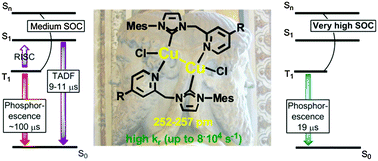Cuprophilic interactions in highly luminescent dicopper(i)–NHC–picolyl complexes – fast phosphorescence or TADF?†
Abstract
This case study on a series of monomeric, dimeric and polymeric CuI chlorido NHC–picolyl complexes shows that cuprophilic interactions can ensure strong spin–orbit coupling for fast (reverse)intersystem-crossing T1 ↔ S1 and T1 → S0, and therefore can serve as a design motif for the construction of highly efficient CuI-based TADF or T1 emitters.



 Please wait while we load your content...
Please wait while we load your content...